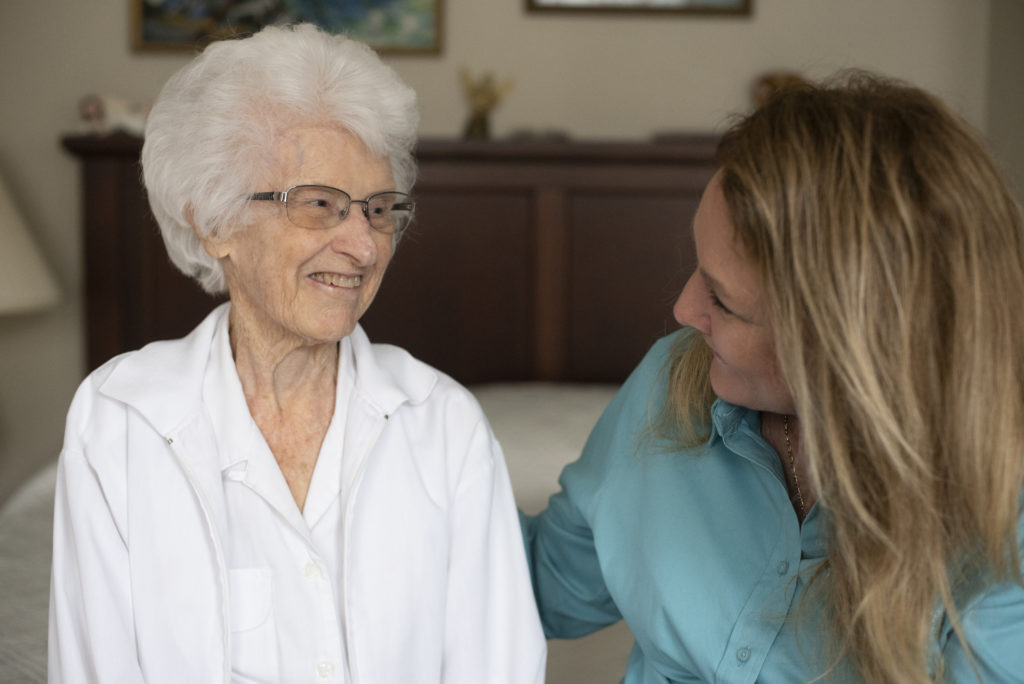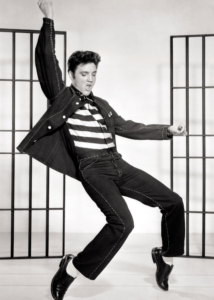By Marie Marley, KCH Volunteer
Published: January 24, 2023
“I have a new patient for you,” said the volunteer coordinator from Kansas City Hospice & Palliative Care (KCH), where I volunteer to visit patients. She continued. “This one may be challenging. Her name is Martha [not her real name]. She is 98, has Alzheimer’s, and doesn’t hardly talk to anyone. Her primary method of communicating is just to blink her eyes.”
“Well, we’ll see about that,” I said, swallowing the last bite of my breakfast bagel. “Maybe I can get her to talk.”
“Good luck!”
I fought my way through heavy traffic and a steady downpour on my way to Martha’s nursing home the next morning. When I arrived, I went to her room and peeked in. The room was empty; I hoped she hadn’t passed away.
That was the thing about volunteering with hospice—all of your patients died. I’d known what I was getting into when I signed on, but was still sometimes shocked when they actually passed away.
I saw an aide in the corridor. “I’m from Kansas City Hospice,” I said, pointing to my nametag. “I’m supposed to visit Martha, but she isn’t in her room.”
“Oh. She’s down in the dining room, just at the end of this hallway.”
I walked toward the dining room. Red construction-paper hearts were affixed to each patient’s door. Valentine’s Day was rapidly approaching, and I assumed the residents had made the hearts during a recent activity session.
When I arrived, I asked the nearest young server which lady was Martha. He pointed to a white-haired woman attired in a yellow nightgown that was covered with a white sweater. I walked over to her table, upon which sat every manner of spilled food. Apparently, Martha wasn’t too skilled at handling utensils.
Looking up as I introduced myself, she smiled but said nothing. I put my hand on her shoulder for a moment, then sat down across from her and began talking—just small talk really, but I had the feeling she understood every word I said.
“Would you like me to take you back to your room now?” I asked when she finished eating.
Again, she said nothing, but blinked her cloudy blue eyes repeatedly. I took that for a “yes,” and pushed her wheelchair down the corridor. When we arrived, I turned the wheelchair around so she could see me.
Since she wasn’t talking, I decided to try playing music for her. I knew that music can often reach people with Alzheimer’s when nothing else does.

“What kind of music do you like, Martha?” I asked, as though talking to a fully lucid person who naturally would answer.
She looked me right in the eye. “Music!” she said loudly.
I was surprised. She’d actually spoken, but hadn’t specified what kind of music she liked, so I tried playing Elvis. I knew from previous experience that many people with Alzheimer’s loved Elvis. The minute “Jailhouse Rock,” emanated from my phone, she came alive. She tapped her toes in time to the music and got a big smile on her face. She even mouthed some of the words. I’d hit the jackpot.
“Which Elvis song would you like to hear next,” I asked her, again as though I anticipated that she’d answer.
“Hound Dog!” she exclaimed.
I was amazed. She had spoken again, and even knew the name of another Elvis song. So I decided to ask her more questions, still speaking to her just as you’d speak to a person without Alzheimer’s.
“Who is your favorite singer?”
“Elvis!” she fairly shouted.
We listened to Elvis on and off for another half hour, alternating between listening and talking. She spoke to me like a perfectly normal person, although it was obvious that her memory was impaired.
“I have to go now, Martha,” I said as I slipped my phone back into my purse. “But I’ll come back soon and play more Elvis for you.”
“Don’t come,” she said sternly, “if you don’t bring Elvis!”
I burst out laughing. Not only was she speaking, she had a fantastic dry sense of humor as well.
I nearly danced my way to the car. All the way home, “Hound Dog” resounded in my head. I realized that I felt better than when I’d arrived. I could hardly wait to call the volunteer coordinator and tell her I had, as I’d dared hope, gotten Martha to talk, and that she was a delightful lady.
I had many more enjoyable visits with Martha. Each time we listened to Elvis and conversed between songs. And, as always, the music lifted my mood as well as hers.
 Once I took Martha a picture of Elvis. When I handed it to her, she took one look, and then said, “It looks just like him!”
Once I took Martha a picture of Elvis. When I handed it to her, she took one look, and then said, “It looks just like him!”
I had to stifle a laugh. She was perfectly serious.
She pressed the photo to her chest and said, “I’m going to sleep with him right here over my heart.” Then she winked at me. She was back to kidding again.
After a few months, Martha’s health began declining. When I went to visit one day, she wasn’t in her room. Assuming she was in the dining room, as usual, I went down to get her. Scanning the tables, I didn’t see her.
Then one of the residents sitting at a table in the far corner recognized me as a regular visitor to Martha.
“She went home,” the lady said, pointing upward.
“What,” I asked, genuinely confused.
She unsteadily walked toward me. “Home,” she repeated, pointing again. “She went home.”
Finally, I understood and trudged out to my car. I could taste the salty tears falling down my cheeks onto the steering wheel. I’d miss Martha so much. She had been a blessing to me, and I was so glad I’d volunteered with Kansas City Hospice.
As a volunteer at Kansas City Hospice & Palliative Care you can make a difference in the lives of people who are facing serious illnesses, their families, and the community. There are many ways to get involved including becoming a community volunteer, Story Boutique volunteer, or an ongoing volunteer, where, like me, you can visit patients in their homes, care facilities, or at the two KCH hospice houses. Take a moment to learn more about volunteer opportunities and how your talents and interests can make a difference in someone’s life.
Marie Marley is a Kansas City Hospice volunteer and author of the award-winning book, “Come Back Early Today: A Memoir of Love, Alzheimer’s and Joy.” ComeBackEarlyToday.com
Posted in Volunteer Impact
